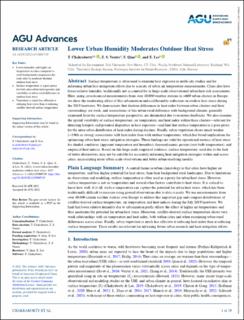| dc.description.abstract | Surface temperature is often used to examine heat exposure in multi-city studies and for informing urban heat mitigation efforts due to scarcity of urban air temperature measurements. Cities also have lower relative humidity, traditionally not accounted for in large-scale observational urban heat risk assessments. Here, using crowdsourced measurements from over 40,000 weather stations in ≈600 urban clusters in Europe, we show the moderating effect of this urbanization-induced humidity reduction on outdoor heat stress during the 2019 heatwave. We demonstrate that daytime differences in heat index between urban clusters and their surroundings are weak, and associations of this urban-rural difference with background climate, generally examined from the surface temperature perspective, are diminished due to moisture feedbacks. We also examine the spatial variability of surface temperature, air temperature, and heat index within these clusters—relevant for detecting hotspots and potential disparities in heat exposure—and find that surface temperature is a poor proxy for the intra-urban distribution of heat index during daytime. Finally, urban vegetation shows much weaker (∼1/6th as strong) associations with heat index than with surface temperature, which has broad implications for optimizing urban heat stress mitigation strategies. These findings are valid for operational metrics of heat stress for shaded conditions (apparent temperature and humidex), thermodynamic proxies (wet-bulb temperature), and empirical heat indices. Based on this large-scale empirical evidence, surface temperature, used due to the lack of better alternatives, may not be suitable for accurately informing heat mitigation strategies within and across cities, necessitating more urban-scale observations and better urban-resolving models | en_US |

